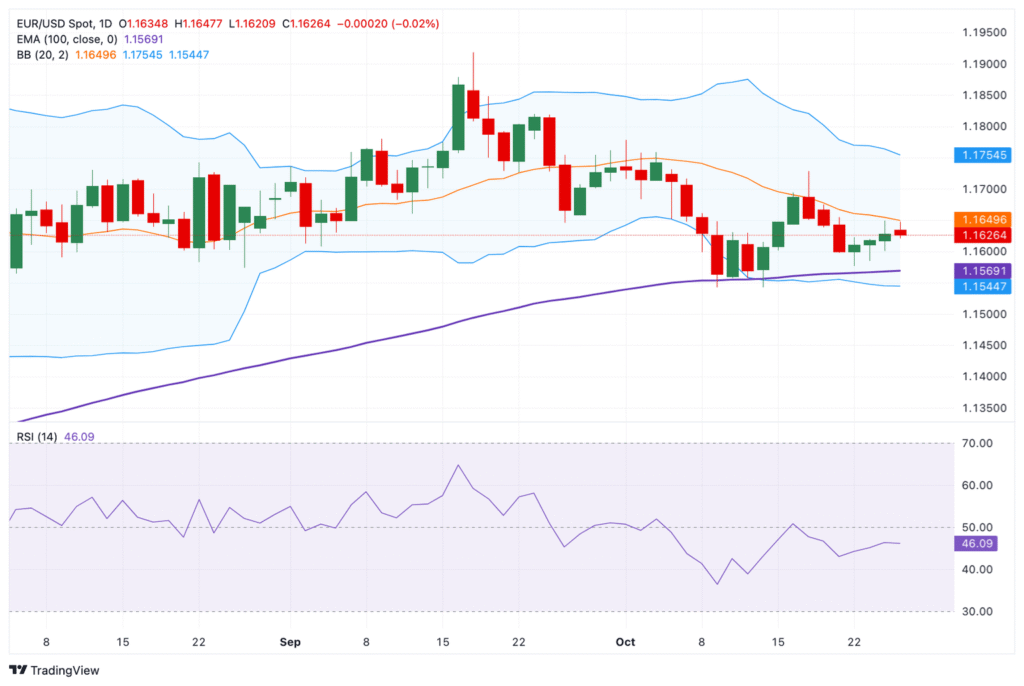The EUR/USD pair loses ground to near 1.1620 during the early European session on Monday. The Euro (EUR) softens against the US Dollar (USD) amid fears of political turmoil in France. France’s Socialist party leader has threatened to bring down Prime Minister Sébastien Lecornu’s government by Monday if their budget conditions are not met.
Olivier Faure, whose party holds a swing vote in the hung parliament, said that he would file a no-confidence bill early next week if billionaires are not forced to pay more tax.
Technically, the constructive outlook of EUR/USD remains in place as the major pair is holding above the key 100-day Exponential Moving Average (EMA) on the daily chart. However, the 14-day Relative Strength Index (RSI) stands below the midline near 45.75. This indicates that further downside looks favorable in the near term.
On the bright side, the first upside barrier emerges at 1.1694, the high of October 16. Any follow-through buying above the mentioned level could see a rally to 1.1755, the upper boundary of the Bollinger Band. Further north, the next resistance level is seen at 1.1820, the high of September 23.
In the bearish case, the 100-day EMA of 1.1575 acts as a key support level for EUR/USD. A breach of this level could drag the major pair toward 1.1545, the lower limit of the Bollinger Band. The additional downside filter to watch is 1.1403, the low of July 31.
EUR/USD daily chart
Euro FAQs
The Euro is the currency for the 19 European Union countries that belong to the Eurozone. It is the second most heavily traded currency in the world behind the US Dollar. In 2022, it accounted for 31% of all foreign exchange transactions, with an average daily turnover of over $2.2 trillion a day.
EUR/USD is the most heavily traded currency pair in the world, accounting for an estimated 30% off all transactions, followed by EUR/JPY (4%), EUR/GBP (3%) and EUR/AUD (2%).
The European Central Bank (ECB) in Frankfurt, Germany, is the reserve bank for the Eurozone. The ECB sets interest rates and manages monetary policy.
The ECB’s primary mandate is to maintain price stability, which means either controlling inflation or stimulating growth. Its primary tool is the raising or lowering of interest rates. Relatively high interest rates – or the expectation of higher rates – will usually benefit the Euro and vice versa.
The ECB Governing Council makes monetary policy decisions at meetings held eight times a year. Decisions are made by heads of the Eurozone national banks and six permanent members, including the President of the ECB, Christine Lagarde.
Eurozone inflation data, measured by the Harmonized Index of Consumer Prices (HICP), is an important econometric for the Euro. If inflation rises more than expected, especially if above the ECB’s 2% target, it obliges the ECB to raise interest rates to bring it back under control.
Relatively high interest rates compared to its counterparts will usually benefit the Euro, as it makes the region more attractive as a place for global investors to park their money.
Data releases gauge the health of the economy and can impact on the Euro. Indicators such as GDP, Manufacturing and Services PMIs, employment, and consumer sentiment surveys can all influence the direction of the single currency.
A strong economy is good for the Euro. Not only does it attract more foreign investment but it may encourage the ECB to put up interest rates, which will directly strengthen the Euro. Otherwise, if economic data is weak, the Euro is likely to fall.
Economic data for the four largest economies in the euro area (Germany, France, Italy and Spain) are especially significant, as they account for 75% of the Eurozone’s economy.
Another significant data release for the Euro is the Trade Balance. This indicator measures the difference between what a country earns from its exports and what it spends on imports over a given period.
If a country produces highly sought after exports then its currency will gain in value purely from the extra demand created from foreign buyers seeking to purchase these goods. Therefore, a positive net Trade Balance strengthens a currency and vice versa for a negative balance.
Read the full article here


